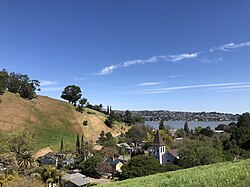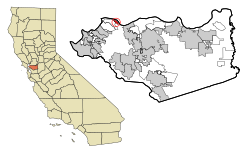Port Costa, California
 From Wikipedia - Reading time: 13 min
From Wikipedia - Reading time: 13 min
Port Costa | |
|---|---|
 Port Costa | |
 Location in Contra Costa County and the state of California | |
| Coordinates: 38°02′47″N 122°11′00″W / 38.04639°N 122.18333°W | |
| Country | |
| State | |
| County | Contra Costa |
| Government | |
| • County Board | District V: Federal Glover |
| • State Senate | Christopher Cabaldon (D)[1] |
| • State Assembly | Anamarie Avila Farias (D)[2] |
| • U. S. Congress | John Garamendi (D)[3] |
| Area | |
• Total | 0.158 sq mi (0.41 km2) |
| • Land | 0.158 sq mi (0.41 km2) |
| • Water | 0 sq mi (0 km2) 0% |
| Elevation | 16 ft (5 m) |
| Population (2020)[6] | |
• Total | 190 |
| • Density | 1,200/sq mi (460/km2) |
| Time zone | UTC-8 (PST) |
| • Summer (DST) | UTC-7 (PDT) |
| ZIP code | 94569 |
| Area code | 510, 341 |
| FIPS code | 06-58226 |
| GNIS feature IDs | 230948, 2409091 |
| [5] | |
Port Costa is a small town and census-designated place (CDP) in Contra Costa County, California, located in the East Bay region of the San Francisco Bay Area. Situated on the southern shore of the Carquinez Strait, the population was 190 in 2020 according to the United States Census Bureau.[6]
History
[edit]
Port Costa was founded in 1879 as a landing for the railroad ferry Solano, owned and operated by the Central Pacific Railroad.[7] This put Port Costa on the main route of the transcontinental railroad.[7] The Solano, later joined by the Contra Costa, carried entire trains across the Carquinez Strait from Benicia to Port Costa,[7] from where they continued on to the Oakland Pier.[7]
Businessman George W. McNear built the Port Costa Warehouses and Dock Company west of the new ferry terminal in 1880. The valley where Port Costa now sits, at one point called Bull Valley, was part of a ranch owned by William Piper. In 1883, McNear bought Piper's land for $100,000 and began to build up the town. Port Costa became the busiest port on the West Coast, primarily shipping wheat.[8]
Port Costa's first post office was established in 1881 with postmaster Kate Hurley. It later moved to a warehouse built by McNear, where it remains today.[9][8] The Port Costa School, a classical revival building designed by architect William Wilde, was built in 1911, opened in 1912, and operated until 1966. In 1988, it was added to the National Register of Historic Places.[10] St. Patrick Church was founded in 1884, rebuilt in 1898, and restored in 1980.[11]
For the early decades of Port Costa's existence, much of the town's commercial activities took place on wharves and docks along the waterfront. These wharves and docks suffered from numerous fires between 1883 and 1941, and a large part of the "Waterfront Port Costa" area was demolished in 1921 after being badly damaged by shipworms. No docks or wharves are left standing today, although pilings remain.[8]
Besides the railroad and shipping, another important industry in Port Costa was brick making.[8] Port Costa Brick Works operated from 1905 until 1991.[12]
After California's wheat output dropped in the early 20th century and especially after the Southern Pacific (which took over the operations of the Central Pacific) constructed a railroad bridge at Martinez in 1930 to replace the ferry crossing, Port Costa lost population and importance.[7]
In 1963, Bill Rich purchased and renovated multiple Port Costa buildings, including the Burlington Hotel (built circa 1883) and McNear's warehouse (built 1886), with the goal of making the town a tourist attraction. Under this iteration, the warehouse housed multiple antique stores and, for two years, artist Clayton Bailey's Wonders of the World Museum. However, Port Costa fell into decline after a 1983 fire in the hills between Port Costa and Crockett.[8]
In 1999, known biker bar the Warehouse Cafe, located in the warehouse originally built by McNear, was purchased by a new owner and gained a "cult following" over the decades.[13] In 2012, the restaurant Bull Valley Roadhouse, which sits in McNear's old office building, was renovated.[14][8] In the following year, the Burlington Hotel was renovated by new owners as well.[15] Port Costa continues to be a destination for day or weekend trips.[16][17]

Geography
[edit]According to the United States Census Bureau, the CDP has a total area of 0.16 square miles (0.41 km2), all of it land. Port Costa is surrounded by rolling hills grazed by cattle and managed by East Bay Regional Park District. Carquinez Strait Regional Shoreline stretches from Crockett through Port Costa and to Martinez. Big Bull Valley Creek runs along McEwen Road into a historic reservoir just above the town, then it runs in an underground pipe culvert beneath the town to the Carquinez Strait.[18]
At the 2000 census, the CDP had a total area of 0.68 square miles (1.8 km2), all of it land.[19]
Demographics
[edit]| Census | Pop. | Note | %± |
|---|---|---|---|
| 2000 | 232 | — | |
| 2010 | 190 | −18.1% | |
| 2020 | 190 | 0.0% | |
| U.S. Decennial Census[20] 1860–1870[21][22] 1880-1890[23] 1900[24] 1910[25] 1920[26] 1930[27] 1940[28] 1950[29] 1960[30] 1970[31] 1980[32] 1990[33] 2000[19] 2010[34] | |||
Port Costa first appeared as a census designated place in the 2000 U.S. Census.[19]

2020
[edit]The 2020 United States census reported that Port Costa had a population of 190. The population density was 1,202.5 inhabitants per square mile (464.3/km2). The racial makeup of Port Costa was 81.1% White, 0.0% African American, 1.1% Native American, 2.6% Asian, 0.0% Pacific Islander, 1.1% from other races, and 14.2% from two or more races. Hispanic or Latino of any race were 9.5% of the population.
The census reported that 100% of the population lived in households.
There were 104 households, out of which 9.6% included children under the age of 18, 33.7% were married-couple households, 6.7% were cohabiting couple households, 36.5% had a female householder with no partner present, and 23.1% had a male householder with no partner present. 43.3% of households were one person, and 25.0% were one person aged 65 or older. The average household size was 1.83. There were 50 families (48.1% of all households).
The age distribution was 9.5% under the age of 18, 6.3% aged 18 to 24, 21.6% aged 25 to 44, 37.9% aged 45 to 64, and 24.7% who were 65 years of age or older. The median age was 50.5 years. For every 100 females, there were 91.9 males.
There were 106 housing units at an average density of 670.9 units per square mile (259.0 units/km2), of which 104 (98.1%) were occupied. Of these, 50.0% were owner-occupied, and 50.0% were occupied by renters.[35][36]
Education
[edit]Port Costa is in the John Swett Unified School District.[37] It previously operated Port Costa School.
Notable people from Port Costa
[edit]See also
[edit]References
[edit]- ^ "Senators". State of California. Retrieved April 1, 2013.
- ^ "Members Assembly". State of California. Retrieved April 1, 2013.
- ^ "California's 8th Congressional District - Representatives & District Map". Civic Impulse, LLC. Retrieved March 9, 2013.
- ^ "2020 U.S. Gazetteer Files". United States Census Bureau. Retrieved July 1, 2025.
- ^ a b "Port Costa". Geographic Names Information System. United States Geological Survey, United States Department of the Interior.
- ^ a b "Port Costa CDP, California - Census Bureau Profile". data.census.gov. United States Census Bureau. Retrieved July 1, 2025.
- ^ a b c d e Images of America: Richmond, by Donald Bastin, Arcadia Publishing (SC), November 2003
- ^ a b c d e f Robinson, John V.; Crane, Veronica (2007). Port Costa. Charleston, SC: Arcadia Pub. ISBN 978-0-7385-4654-4. OCLC 144226491.
- ^ Durham, David L. (1998). California's Geographic Names: A Gazetteer of Historic and Modern Names of the State. Clovis, California: Word Dancer Press. p. 684. ISBN 1-884995-14-4.
- ^ "National Register of Historic Places Continuation Sheet". National Park Service. 1988. Retrieved December 19, 2022.
- ^ "The History of St. Patrick Mission Church". St. Rose of Lima Catholic Church, Crockett, CA. Retrieved February 18, 2024.
- ^ Cuff, Denis (May 29, 2012). "Port Costa brick works to become park land". The Mercury News. Retrieved December 18, 2022.
- ^ Tsai, Luke (October 19, 2020). "How a Remote East Bay Biker Bar Is (Just Barely) Surviving the Pandemic". Eater SF. Retrieved December 18, 2022.
- ^ Bauer, Michael (February 9, 2013). "Bull Valley Roadhouse, Port Costa - old-time vibe". San Francisco Chronicle. Retrieved December 18, 2022.
- ^ May, Meredith (February 6, 2013). "Burlington Hotel in Port Costa restoration". San Francisco Chronicle. Retrieved December 18, 2022.
- ^ "Bay Area Day Trip: A Saturday in Port Costa with hikes, honey and a bit of magic". The Mercury News. March 5, 2020. Retrieved December 18, 2022.
- ^ Bote, Joshua (November 11, 2021). "The tiny port town unlike anywhere else in the Bay Area". SFGATE. Retrieved December 18, 2022.
- ^ U.S. Geological Survey Geographic Names Information System: Big Bull Valley
- ^ a b c "2000 Census of Population - Population and Housing Unit Counts - California" (PDF). United States Census Bureau.
- ^ "Decennial Census by Decade". United States Census Bureau.
- ^ "1870 Census of Population - Population of Civil Divisions less than Counties - California - Almeda County to Sutter County" (PDF). United States Census Bureau.
- ^ "1870 Census of Population - Population of Civil Divisions less than Counties - California - Tehama County to Yuba County" (PDF). United States Census Bureau.
- ^ "1890 Census of Population - Population of California by Minor Civil Divisions" (PDF). United States Census Bureau.
- ^ "1900 Census of Population - Population of California by Counties and Minor Civil Divisions" (PDF). United States Census Bureau.
- ^ "1910 Census of Population - Supplement for California" (PDF). United States Census Bureau.
- ^ "1920 Census of Population - Number of Inhabitants - California" (PDF). United States Census Bureau.
- ^ "1930 Census of Population - Number and Distribution of Inhabitants - California" (PDF). United States Census Bureau.
- ^ "1940 Census of Population - Number of Inhabitants - California" (PDF). United States Census Bureau.
- ^ "1950 Census of Population - Number of Inhabitants - California" (PDF). United States Census Bureau.
- ^ "1960 Census of Population - General population Characteristics - California" (PDF). United States Census Bureau.
- ^ "1970 Census of Population - Number of Inhabitants - California" (PDF). United States Census Bureau.
- ^ "1980 Census of Population - Number of Inhabitants - California" (PDF). United States Census Bureau.
- ^ "1990 Census of Population - Population and Housing Unit Counts - California" (PDF). United States Census Bureau.
- ^ "2010 Census of Population - Population and Housing Unit Counts - California" (PDF). United States Census Bureau.
- ^ "Port Costa CDP, California; DP1: Profile of General Population and Housing Characteristics - 2020 Census of Population and Housing". US Census Bureau. Retrieved March 27, 2025.
- ^ "Port Costa CDP, California; P16: Household Type - 2020 Census of Population and Housing". US Census Bureau. Retrieved March 27, 2025.
- ^ 2020 CENSUS - SCHOOL DISTRICT REFERENCE MAP: Contra Costa County, CA (PDF) (Map). Suitland, Maryland: U.S. Census Bureau. Retrieved January 24, 2025. - Text list
- ^ Whiting, Sam (June 8, 2020). "Clayton Bailey, pioneer of 'Nut Art' and the Port Costa Sky Cam, has died". Datebook | San Francisco Arts & Entertainment Guide. Retrieved December 18, 2022.
 KSF
KSF

